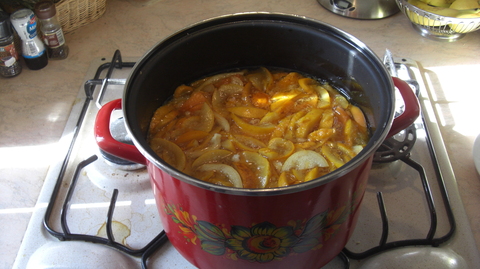Food and Recipes
I like Marmalade

Marmalade is a peculiarly English product. It's not that nobody else does it - you can find an approximation to it on the shelves of your local Carrefour - but the "good stuff", a near solid mass of peel with that unique taste fusion of bitter and sweet, can only be found in English shops. Or English homes.
Marmalade is the subject of an EU decree that the name can only be used for conserves made from citrus fruit. Everything else is jam. Why that particular decree should have been necessary is a bit of a mystery to a true marmalade lover - why would anyone try to make it out of anything but oranges, lemons or other citrus fruit?
It's fortunate for marmalade lovers that it's so easy to make. The only really important thing is to get the right kind of fruit to start with, in particular oranges. Forget the kind you can peel and eat; what you need is the ones that make your eyes water at the merest touch of the tongue to the raw fruit juice. Traditionally that's the Spanish Seville orange, but there are plenty of alternatives, many of them lining the streets of towns up and down the Riviera. There's a good reason why the fruit remains on those trees all winter until it finally falls off in early summer; the locals don't have a use for it as it's so bitter. You can also find scrubby, untended bushes growing on the hillsides; the fruit may be small but it's packed full of juice bitter enough to strip varnish. But take care, everything round here, however abandoned-looking, is owned by someone; you may want to bear that in mind when organising a raiding party. If you're forced to go and buy oranges, the key word is "amère" in French or "amara" in Italian, both meaning "bitter".
So on to the marmalade recipe. I'm assuming you're not a lover of Golden Shred, a pale insipid jelly with about ten wispy flakes of peel per jar. That's just for wusses and foreigners. The kind I'm describing here is caramel brown, almost 100% peel and roughly the texture of half-set concrete.
Ingredients:
2kg mixed bitter oranges and lemons
2kg sugar (vary to taste)
First of all, collect your fruit. We'll be making batches of about 2kg at a time; much more and you'll need a huge pan. It's enough for eight to ten standard jam-jars. Any mixture of oranges and lemons will do, according to preference, but it you're new to this I suggest three of four lemons and the rest bitter oranges as described above.
Wash the fruit. It's been outside all winter and you don't know who's been visiting.
The only bit of the fruit we don't need is the pips. Everything else is sliced or diced, according to whether you like your peel in strips or chunks. I find the easiest way to slice the fruit and extract the pips is to put the whole lot in a pan, cover them with water, bring to the boil and leave them for five minutes or so until the skins soften. Lemons are tough little blighters so they may need longer. Don't throw away the water; just take out the fruit and let it cool before slicing it up and extracting all the pips you can find. Put the sliced fruit back in the pan and add another litre or so of water. It's not really important how much as it'll boil down anyway.
Now bring the pan to the boil and cook the fruit for half an hour or so, then stir in a couple of kilograms of sugar. Let your tongue test how much; if you like very sweet marmalade you'll need more sugar and if you prefer a very bitter conserve go for less. Continue boiling gently until the juice starts to caramelise, taking on a progressively deeper golden colour. At this point you need to keep stirring regularly or it will burn. In a non-stick pan it will weld itself to the bottom, virtually impossible to remove, as has happened to the pan in the picture.
A little tip here. You'll find that any of the pips you missed while slicing will tend to float to the top during boiling, so keep your eyes open for them as you stir. Nobody likes finding orange pips on their breakfast toast.
From time to time, take a little of the juice, drop it onto a cold plate and let it cool. If the puddle runs about when you tip the plate it's not done yet. Once it starts to set like toffee you're there, so have your jars ready. Avoid those with plastic lids; the best ones are those with the metal lids that go 'pop' as their contents cool and a vacuum builds up inside. You can buy them from places like Nuovo Agrotechnica in Camporosso or you can re-use jam jars or those previously containing olives, pesto or last year's marmalade. Modern jars work several times before the lids get tired.
Spoon the hot marmalade into each jar and put on the lid. Have a washing-up bowl of water ready, both to clean the outside of each jar and to save burning your hands as you screw on the lids. Place the jars to one side and enjoy listening to the lids pop over the next few hours. Such simple pleasure.
And that's it. If you're really organised, labelling may help and it impresses people you give jars to as presents. Or like me you may want to keep it all for yourself.
Enjoy your marmalade!



